Alexandria, Virginia, Hgh State Clinic, Hgh Injections, Hrt Doctors
Alexandria, Virginia Blood Testing Facilities
 Represents a LabCorp blood testing facility
Represents a LabCorp blood testing facility Represents a Quest Diagnostics blood testing facility
Represents a Quest Diagnostics blood testing facility

Nearby Labcorp Blood Testing facilities:
- Labcorp Center Distance: 3 m, 5130 Duke St Ste 10, Alexandria, Other, VA, 22304
- Labcorp Center Distance: 4 m, 1328 Southern Ave Se Ste 207, Washington, Other, DC, 20032
- Labcorp Center Distance: 6 m, 1133 21St St Nw Bldg 2, Washington, Other, DC, 20036
- Labcorp Center Distance: 7 m, 1145 19Th St Nw Ste 601, Washington, Other, DC, 20036
- Labcorp Center Distance: 8 m, 106 Irving Street Nw Ste 1506, Washington, Other, DC, 20010
- Labcorp Center Distance: 10 m, 8191 Strawberry Lane 3Rd Level, Falls Church, Fairfax County, VA, 22042
- Labcorp Center Distance: 11 m, 9560 Pennsylvania Ave. Ste 203, Upper Marlboro, Prince George's County, MD, 20772
- Labcorp Center Distance: 12 m, 3311 Toledo Terrace Ste B101, Hyattsville, Prince George's County, MD, 20782
- Labcorp Center Distance: 13 m, 6510 Kenilworth Ave. Ste 1500, Riverdale, Prince George's County, MD, 20737
- Labcorp Center Distance: 14 m, 11350 Pembrooke Sq Ste 301, Waldorf, Charles County, MD, 20603
- Labcorp Center Distance: 15 m, 7525 Greenway Center Dr Ste 104, Greenbelt, Prince George's County, MD, 20770
- Labcorp Center Distance: 16 m, 11120 New Hampshire Ave Ste 306, Silver Spring, Montgomery County, MD, 20904
- Labcorp Center Distance: 17 m, 14010 Smoketown Road Ste 101, Woodbridge, Prince William County, VA, 22192
- Labcorp Center Distance: 18 m, 12210 Plum Orchard Dr Ste 215, Silver Spring, Montgomery County, MD, 20904
- Labcorp Center Distance: 20 m, 4000 Mitchellville Rd Ste 420B, Bowie, Prince George's County, MD, 20716
- Labcorp Center Distance: 21 m, 7350 Van Dusen Rd Ste B, Laurel, Prince George's County, MD, 20707
- Labcorp Center Distance: 22 m, 15225 Shady Grove Rd Ste 204, Rockville, Montgomery County, MD, 20850
- Labcorp Center Distance: 23 m, 8609 Sudley Rd Ste 104, Manassas, Other, VA, 20110
- Labcorp Center Distance: 24 m, 18109 Prince Philip Dr Ste 100, Olney, Montgomery County, MD, 20832
- Labcorp Center Distance: 25 m, 814 West Diamond Ave. Ste 105, Gaithersburg, Montgomery County, MD, 20878
- Labcorp Center Distance: 27 m, 43810 Central Station Dr 160, Ashburn, Loudoun County, VA, 20147
- Labcorp Center Distance: 28 m, 19851 Observation Dr Ste 315, Germantown, Montgomery County, MD, 20876
- Labcorp Center Distance: 29 m, 44035 Riverside Pkwy Ste 310, Leesburg, Loudoun County, VA, 20176
- Labcorp Center Distance: 30 m, 7556 Teague Rd Ste 470, Hanover, Anne Arundel County, MD, 21076
- Labcorp Center Distance: 31 m, 5450 Knoll North Dr Ste 150, Columbia, Howard County, MD, 21045
- Labcorp Center Distance: 32 m, 22616 Gateway Ctr Dr. Ste 600, Clarksburg, Montgomery County, MD, 20871
- Labcorp Center Distance: 33 m, 8028 Ritchie Hwy Ste 112, Pasadena, Anne Arundel County, MD, 21122
- Labcorp Center Distance: 34 m, 222 Catoctin Cir Se Ste 100, Leesburg, Loudoun County, VA, 20175
- Labcorp Center Distance: 35 m, 1412 N Crain Hwy Ste 3A, Glen Burnie, Anne Arundel County, MD, 21061
- Labcorp Center Distance: 36 m, 4231 Postal Court Ste 101, Pasadena, Anne Arundel County, MD, 21122
- Labcorp Center Distance: 38 m, 3449 Wilkens Ave Ste 207, Baltimore, Other, MD, 21229
- Labcorp Center Distance: 39 m, 205 Center Street Suite 204, Mount Airy, Carroll County, MD, 21771
- Labcorp Center Distance: 41 m, 9701 Hospital Blvd. Ste 103, Fredericksburg, Other, VA, 22408
- Labcorp Center Distance: 42 m, 3700 Fleet St Ste 101, Baltimore, Other, MD, 21224
- Labcorp Center Distance: 43 m, 2112 Didonato Dr Ste F, Chester, Queen Anne's County, MD, 21619
- Labcorp Center Distance: 44 m, 2511 Salem Church Rd, Fredericksburg, Spotsylvania County, VA, 22407
- Labcorp Center Distance: 47 m, 110 Baughmans Ln Ste 180, Frederick, Frederick County, MD, 21702
- Labcorp Center Distance: 48 m, 141 Thomas Johnson Dr Ste 100, Frederick, Frederick County, MD, 21702
- Labcorp Center Distance: 49 m, 1774 York Rd, Lutherville, Baltimore County, MD, 21093
- Labcorp Center Distance: 51 m, 10 Warren Rd Ste 260, Cockeysville, Baltimore County, MD, 21030
- Labcorp Center Distance: 52 m, 226 Washington Hts Med Ctr A, Westminster, Carroll County, MD, 21157
- Labcorp Center Distance: 53 m, 401 Purdy St Ste 202, Easton, Talbot County, MD, 21601
- Labcorp Center Distance: 55 m, 503 Byrn St 2Nd Fl, Cambridge, Dorchester County, MD, 21613
- Labcorp Center Distance: 60 m, 514 Washington Ave Ste 4, Chestertown, Kent County, MD, 21620
- Labcorp Center Distance: 61 m, 2021A Emmorton Rd Ste 122, Bel Air, Harford County, MD, 21015
- Labcorp Center Distance: 62 m, 602 S Atwood Rd 204, Bel Air, Harford County, MD, 21014
- Labcorp Center Distance: 66 m, 1724 Amherst St, Winchester, Other, VA, 22601
- Labcorp Center Distance: 67 m, 338 Mill St, Hagerstown, Washington County, MD, 21740
- Labcorp Center Distance: 72 m, 251 Lewis Lane Ste 304, Havre De Grace, Harford County, MD, 21078
- Labcorp Center Distance: 78 m, 701 Health Services Dr, Seaford, Sussex County, DE, 19973
- Labcorp Center Distance: 80 m, 239 Pauline Dr (S York Plaza), York, York County, PA, 17402
Nearby Quest Blood Testing facilities:
- Quest Center Distance: 5 m, 6162 Fuller Ct, Alexandria, Fairfax County, VA, 22310-2540
- Quest Center Distance: 6 m, 2141 K St Nw, Washington, Other, DC, 20037-1883
- Quest Center Distance: 7 m, 1145 19Th St, Nw, Washington, Other, DC, 20036-3713
- Quest Center Distance: 11 m, 8501 Arlington Blvd, Fairfax, Fairfax County, VA, 22031-4632
- Quest Center Distance: 14 m, 10721 Main Street, Fairfax, Other, VA, 22030-6912
- Quest Center Distance: 15 m, 6201 Greenbelt Rd, College Park, Other, MD, 20740-2358
- Quest Center Distance: 16 m, 2080 Daniel Stuart Square, Woodbridge, Prince William County, VA, 22191-3315
- Quest Center Distance: 18 m, 12731 Marblestone Dr, Woodbridge, Prince William County, VA, 22192-8307
- Quest Center Distance: 20 m, 4000 Mitchellville Road, Bowie, Prince George's County, MD, 20716-3124
- Quest Center Distance: 21 m, 9707 Medical Center Drive, Rockville, Montgomery County, MD, 20850-6335
- Quest Center Distance: 22 m, 15225 Shady Grove Road, Rockville, Montgomery County, MD, 20850-3200
- Quest Center Distance: 23 m, 8685 Sudley Rd, Manassas, Other, VA, 20110-4588
- Quest Center Distance: 24 m, 18111 Prince Philip Drive, Olney, Montgomery County, MD, 20832-1522
- Quest Center Distance: 25 m, 14 Pidgeon Hill Dr, Sterling, Loudoun County, VA, 20165-6151
- Quest Center Distance: 26 m, 21785 Filigree Court, Ashburn, Loudoun County, VA, 20147-6214
- Quest Center Distance: 29 m, 20528 Boland Farm Road, Germantown, Montgomery County, MD, 20876-4038
- Quest Center Distance: 30 m, 14370 Lee Highway, Gainesville, Prince William County, VA, 20155-4865
- Quest Center Distance: 31 m, 608 Garrisonville Rd, Stafford, Stafford County, VA, 22554-3706
- Quest Center Distance: 32 m, 200 Hospital Drive, Glen Burnie, Anne Arundel County, MD, 21061-5861
- Quest Center Distance: 34 m, 521 E. Market St., Leesburg, Loudoun County, VA, 20176-4170
- Quest Center Distance: 38 m, 2 East Rolling Crossroads, Catonsville, Baltimore County, MD, 21228-6212
- Quest Center Distance: 40 m, 2300 Garrison Blvd, Baltimore, Other, MD, 21216-2309
- Quest Center Distance: 41 m, 1011 Care Way, Fredericksburg, Other, VA, 22401-4454
- Quest Center Distance: 44 m, 23 Crossroads Dr, Owings Mills, Baltimore County, MD, 21117-5420
- Quest Center Distance: 46 m, 4545 Spotsylvania Parkway, Fredericksburg, Spotsylvania County, VA, 22408-7768
- Quest Center Distance: 48 m, 165 Thomas Johnson Dr, Frederick, Frederick County, MD, 21702-4314
- Quest Center Distance: 52 m, 222 Washington Road, Westminster, Carroll County, MD, 21157-5611
- Quest Center Distance: 62 m, 620 W Macphail Road, Bel Air, Harford County, MD, 21014-4474
- Quest Center Distance: 66 m, 812 Amherst St, Winchester, Other, VA, 22601-3344
- Quest Center Distance: 71 m, 626 E Main St, Waynesboro, Franklin County, PA, 17268-2387
- Quest Center Distance: 78 m, 808 Middleford Rd, Seaford, Sussex County, DE, 19973-3650
- Quest Center Distance: 82 m, 1550 Rodney Rd, York, York County, PA, 17408-9715
- Quest Center Distance: 83 m, Ketley Professional Plaza - 114 Sandhill Drive, Middletown, New Castle County, DE, 19709-1495
- Quest Center Distance: 84 m, 712 E Main St, Salisbury, Wicomico County, MD, 21804-5037
- Quest Center Distance: 85 m, 1102 South Dupont Highway, Dover, Kent County, DE, 19901-4113
- Quest Center Distance: 87 m, 975 N Dupont Hwy, Milford, Kent County, DE, 19963-1072
- Quest Center Distance: 88 m, 300 Biddle Ave, Newark, New Castle County, DE, 19702-3972
- Quest Center Distance: 93 m, 1807 Huguenot Road, Midlothian, Chesterfield County, VA, 23113-5604
- Quest Center Distance: 95 m, A98 100 Omega Drive, Newark, New Castle County, DE, 19713-2049
- Quest Center Distance: 97 m, 5311 Limestone Rd, Wilmington, New Castle County, DE, 19808-1222
- Quest Center Distance: 98 m, 4512 Kirkwood Hwy, Wilmington, New Castle County, DE, 19808-5125
Alexandria Virginia Hormone Replacement Therapy Services
Hormone Optimization is at the forefront of the modern Health and Wellness landscape. Generations of research have shown exactly how important Hormone Homeostasis is to living a long and healthy life, and we at the Conscious Evolution Institute specialize in Comprehensive Hormone Therapy Programs designed to help you enhance your vitality by restoring Hormone Balance.
Our licensed and board-certified Hormone Clinic specializes in treating men and women thirty years of age and older that are concerned about preserving or restoring their natural Hormone Balance. We are proud to serve the city of Alexandria, as well as the greater Washington D.C. Metropolitan area, and we have highly qualified local medical affiliates in your area that can help us get you the impactful and effective HRT Treatments that can enhance your life.
If you'd like to learn more about Prescription Hormone Therapy with Bio-Identical Testosterone, Human Growth Hormone, Sermorelin Acetate, or any other form of Hormone Optimization, our trained Hormone Specialists are available to answer any questions that you may have, or to set you up with an appointment with a doctor for preliminary Hormone Screening. Just call the number that you see on your screen, or fill out the form on this page to get started!
Alexandria Virginia Testosterone Therapy Clinics
Testosterone is the quintessential male hormone. It's the reason why men have strong bones, strong muscles, lean bodies, and sexual vigor and potency. When Testosterone Levels are too low, it literally drains male vitality. It leads to increased risk of obesity, diabetes, and cardiovascular disease. It increases feelings of fatigue, depression, and anxiety. It causes all of this on top of devastating libido and increasing the risk of Erectile Dysfunction.
If our tests show that you can benefit from Low-T Treatment, we can provide you with a safe, effective, and potent Testosterone Prescription. We offer many forms of Bio-Identical Testosterone, including Low-T Patches, Testosterone Replacement Creams, and even cost-effective Testosterone Injections.
Most patients suffering from Age-Related Testosterone Deficiency experience significant physical and psychological benefits over the course of six months of regular treatment. Don't be embarrassed about your sexual issues and don't let your fears contribute to the further harms associated with Testosterone Deficiency. Talk to a qualified Hormone Doctor today!
Human Growth Hormone Therapy in Alexandria Virginia
Recombinant HGH Therapy is another of the fine Hormone Therapy Options that we offer at the Conscious Evolution Institute. Human Growth Hormone is the primary hormone responsible for controlling and modulating cellular metabolism. This is a very important job that has vast and powerful beneficial effects on systems all throughout the body.
Sadly, natural HGH Levels start to fall into decline in both sexes beginning around thirty years of age. The negative effects of Age-Associated Growth Hormone Deficiency take years to manifest, but can have a life-altering impact on long-term health and wellness. Patients with HGH Deficiency experience all sorts of negative health consequences such as low-energy, weight gain, loss of strength and muscle mass, depression, cognitive decline, premature aging of the skin, and weakened immune system. If our tests show that you can benefit from Recombinant HGH Injections, we can deliver Prescription Growth Hormone straight to your home so that you can start treatment right away.
Sermorelin Therapy Prescriptions for Alexandria Virginia
We also offer an alternative to natural Human Growth Hormone that has become increasingly popular in recent years, known as Sermorelin Acetate. Sermorelin has the same net benefits as Prescription HGH, it just works via a different yet equally effective mechanism. Rather than introducing Bio-Identical HGH through daily injections, Sermorelin stimulates the human pituitary gland to release its own Human Growth Hormone.
You see, most people with Adult HGH Deficiency (Also referred to as Somatopause) retain the ability to produce their own Growth Hormone, it's just that HGH Precursors become less abundant, reducing pituitary activity. Sermorelin Acetate resolves this inactivity by encouraging the release of Human Growth Hormone at levels and intervals closely associated with early adulthood. Sermorelin is cheaper than Bio-Identical HGH, and can be prescribed off-label, as opposed to Human Growth Hormone, allowing our Hormone Specialists the flexibility to treat patients that could benefit from HGH Therapy that fall through the cracks.
Alexandria Virginia Information
Alexandria Virginia is a wealthy suburb of Washington D.C. that sits just to the west of the United States Capital, just across the famous Potomac River. Alexandria is just a short seven miles away from the downtown of the District of Columbia, and is well-connected via the Washington Metro and other forms of Mass Transit, making it the hottest spot for commuters in the D.C. area. Neighborhoods in Alexandria include Old Town West, North Ridge, Westover, Landmark, Southwest Quadrant, Arlandia, Rosemont Historic District, Northeast Alexandria, Potomac West, Alexandria West, Del Ray, and Old Town.
Because of how near Alexandria is to Washington D.C., many of the largest employers are federal government and military institutions like Departments of Defense and Commerce. Other major employers in the city include Oblon, the Institute for Defense Analyses, and Inova Health System. A number of unions and other organizations important to national industry and charity are based out of Alexandria, such as the Salvation Army, United Way, and the American Diabetes Association.
There are lots of things to see and do in Alexandria, most notably Mount Vernon, the country estate of George Washington that overlooks Washington D.C. There are also many other historic homes and landmarks such as Jones Point Lighthouse, Alexandria National Cemetary, the Lyceum, and Fort Ward.
All About Alexandria, Virginia Geographic Area
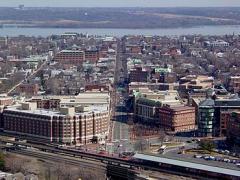
Alexandria is an independent city in the Commonwealth of Virginia. As of 2010, the city had a total population of 139,966. Located along the Western bank of the Potomac River, Alexandria is approximately six miles (9.6 kilometers) south of downtown Washington, D.C.
Like the rest of Northern Virginia, as well as central Maryland, modern Alexandria has been shaped by its proximity to the nation's capital. It is largely populated by professionals working in the federal civil service, the U.S. military, or for one of the many private companies which contract to provide services to the federal government. The latter are known locally as beltway bandits, after the Capital Beltway, an interstate highway that circles Washington, D.C. One of Alexandria's largest employers is the U.S. Department of Defense. Others include the Institute for Defense Analyses and the Center for Naval Analyses. In 2005, the United States Patent and Trademark Office moved 7,100 employees from 18 separate buildings in nearby Crystal City into a new headquarters complex in the city.
The historic center of Alexandria is known as Old Town. With its concentration of boutiques, restaurants, antique shops and theaters, it is a major draw for tourists. Like Old Town, many Alexandria neighborhoods are compact, walkable, high-income suburbs of Washington D.C. It is the seventh largest and highest income independent city in Virginia.
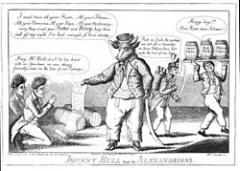
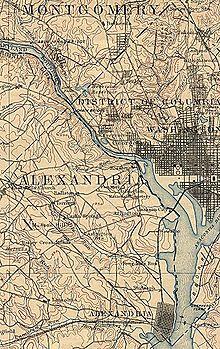
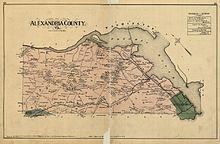
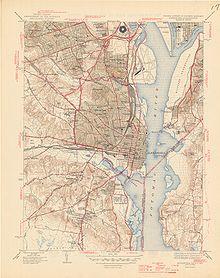
The first settlement was established in 1695 in what was then the English Colony of Virginia. Virginia's comprehensive Tobacco Inspection Law of 1730 mandated that all tobacco grown in the colony must be brought to locally designated public warehouses for inspection before sale: one of the sites designated for a warehouse on the upper Potomac River was at the mouth of Hunting Creek. However, the ground being unsuitable at that location, the warehouse was established a half-mile up river, where the water ran deep near the shore.
Following the 1745 settlement of the colony's 10-year long dispute with Lord Fairfax over the western boundary of the Northern Neck Proprietary aethe Privy Council in London finding in favor of Lord Fairfax's expanded claim aesome of the gentry class of Fairfax County banded together to form the Ohio Company of Virginia. Their intent was to establish trade into the interior of America and for this they required an entrepot close to the head of navigation on the Potomac. The Hunting Creek tobacco warehouse offered the best location for a trading port which could accommodate sailing ships. However, many of the local tobacco planters wanted a new town to be sited up Hunting Creek, away from the "played out" tobacco fields along the river.
Around 1746, Captain Philip Alexander II (1704 ae1753) moved to what is south of present Duke Street in Alexandria. His estate, which consisted of 500 acres (2.0 km2), was bounded by Hunting Creek, Hooff aos Run, the Potomac River, and approximately the line which would become Cameron Street. At the opening of Virginia's 1748 ae49 legislative session, there was a petition submitted in the House of Burgesses on November 1, 1748, that the "inhabitants of Fairfax (Co.) praying that a town may be established at Hunting Creek Warehouse on Potowmack River," as Hugh West was the owner of the warehouse. The petition was introduced by Lawrence Washington (1718-1752), the representative for Fairfax County and, more importantly, the son-in-law of William Fairfax and a founding member of the Ohio Company. To support the Company's push for a town on the river, Lawrence's younger brother George Washington, an aspiring surveyor, made a sketch of the shoreline touting the advantages of the tobacco warehouse site.
Since the river site was amidst his estate, Philip opposed the idea and strongly favored a site at the head of Hunting Creek (also known as Great Hunting Creek). It has been said that in order to avoid a predicament the petitioners offered to name the new town Alexandria, in honor of Philip aos family. As a result, Philip and his cousin Captain John Alexander (1711 ae1763) gave land to assist in the development of Alexandria, and are thus listed as the founders. This John was the son of Robert Alexander II (1688 ae1735). On May 2, 1749, the House of Burgesses approved the river location and ordered "Mr. Washington do go up with a Message to the Council and acquaint them that this House have agreed to the Amendments titled An Act for erecting a Town at Hunting Creek Warehouse, in the County of Fairfax." A "Public Vendue" (auction) was advertised for July, and the county surveyor laid out street lanes and town lots. The auction was conducted on July 13 ae14, 1749. Almost immediately upon establishment, the town founders called the new town "Belhaven", believed to be in honor of a Scottish patriot, John Hamilton, 2nd Lord Belhaven and Stenton, the Northern Neck tobacco trade being then dominated by Scots. The name Belhaven was used in official lotteries to raise money for a Church and Market House, but it was never approved by the legislature and fell out of favor in the mid-1750s. The town of Alexandria did not become incorporated until 1779.
In 1755, General Edward Braddock organized his fatal expedition against Fort Duquesne at Carlyle House in Alexandria. In April 1755, the governors of Virginia, and the Provinces of Maryland, Pennsylvania, Massachusetts, and New York met to determine upon concerted action against the French in America.
In March 1785, commissioners from Virginia and Maryland met in Alexandria to discuss the commercial relations of the two states, finishing their business at Mount Vernon. The Mount Vernon Conference concluded on March 28 with an agreement for freedom of trade and freedom of navigation of the Potomac River. The Maryland legislature, in ratifying this agreement on November 22, proposed a conference among representatives from all the states to consider the adoption of definite commercial regulations. This led to the calling of the Annapolis Convention of 1786, which in turn led to the calling of the Federal Convention of 1787.
In 1791, Alexandria was included in the area chosen by George Washington to become the District of Columbia. A portion of the City of Alexandria---known as "Old Town"--- and all of today's Arlington County share the distinction of having been originally in Virginia, ceded to the U.S. Government to form the District of Columbia, and later retroceded to Virginia by the federal government in 1846, when the District was reduced in size to exclude the portion south of the Potomac River. The City of Alexandria was re-chartered in 1852.
In 1814, during the War of 1812, a British fleet launched a successful Raid on Alexandria, which surrendered without a fight. As agreed in the terms of surrender the British looted stores and warehouses of mainly flour, tobacco, cotton, wine, and sugar.
From 1828 to 1836, Alexandria was home to the Franklin & Armfield Slave Market, one of the largest slave trading companies in the country. By the 1830s, they were sending more than 1,000 slaves annually from Alexandria to their Natchez, Mississippi, and New Orleans markets to help meet the demand for slaves in Mississippi and surrounding states. Later owned by Price, Birch & Co., the slave pen became a jail under Union occupation.
The City of Alexandria became independent of Alexandria County in 1870. The remaining portion of Alexandria County changed its name to Arlington County in 1920.
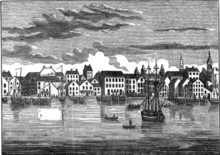
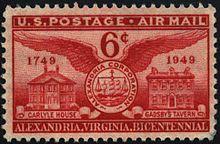
Over time, a movement grew to separate Alexandria from the District of Columbia. As competition grew with the port of Georgetown and the Chesapeake and Ohio Canal fostered development on the north side of the Potomac River, the city's economy stagnated. In addition, many in Alexandria hoped to benefit from land sales and increased business from the federal government, which had no need for the land south of the river at the time. Also, its residents had lost representation and the right to vote at any level of government.
Alexandria was also an important port and market in the slave trade, and there were increasing talk of the abolition of slavery in the national capital. Alexandria's economy would suffer greatly if slavery were outlawed. At the same time, there was an active abolition movement in Virginia, and the state's General Assembly was closely divided on the question of slavery (resulting in the formation of West Virginia some years later by the most anti-slavery counties). Alexandria and Alexandria County would provide two new pro-slavery representatives.
After a referendum, voters petitioned Congress and Virginia to return the area to Virginia. The area was retroceded to Virginia on July 9, 1846.
The first fatalities of the North and South in the American Civil War occurred in Alexandria. Within a month of the Battle of Fort Sumter, where two died, Union troops occupied Alexandria, landing troops at the base of King Street on the Potomac River on May 24, 1861. A few blocks up King Street from their landing site, the commander of the New York Fire Zouaves, Colonel Elmer E. Ellsworth, sortied with a small detachment to retrieve a large Confederate flag displayed on the roof of the Marshall House Inn that had been visible from the White House. While descending from the roof, Ellsworth was killed by Captain James W. Jackson, the hotel proprietor. One of the soldiers in Ellsworth's party shot Jackson immediately thereafter.
Colonel Ellsworth was from Illinois and was a frequent visitor to the White House, where his death was much lamented. After Ellsworth's death, he was publicized as a Union martyr. The incident generated great excitement in the North. Jackson's death caused a lesser, but similar sensation in the South.
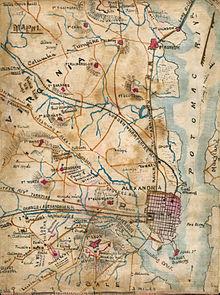
Alexandria remained under military occupation until the end of the Civil War. One of the ring of forts built during the war by the Union army for the defense of Washington, D.C., Fort Ward, is located within the boundaries of modern Alexandria. After the establishment of the state of West Virginia in 1863 and until the close of the war, Alexandria was the seat of the Restored Government of Virginia also known as the "Alexandria Government."
During the Union occupation, a recurring point of contention between the Alexandria citizenry and the military occupiers was the military aos periodic insistence that church services include prayers for the President of the United States. Because the Episcopal Church used a written prayer book service that made distinct mention of both the executive and the legislative departments of the government, Episcopal clergy were exposed to particular embarrassment whenever any part of the territory of the Confederate States was occupied by Union forces.
Alexandria's St. Paul's Episcopal Church was the site of an early and particularly notorious incident. The interim minister at St. Paul's Church, the Rev. Dr. K. J. Stewart, was arrested in the sanctuary on February 9, 1862, by Union troops who had attended with the stated purpose of provoking an incident. During the Litany, Dr. Stewart was ordered by an attending Union officer to say the Prayer for the President of the United States that Dr. Stewart had omitted without saying any other prayer in its place. Dr. Stewart proceeded without paying any attention to the interruption; but a captain and six of his soldiers, who were present in the congregation with intent to provoke an incident, drew their swords and pistols, strode into the chancel, seized the clergyman while he was still kneeling, held pistols to his head, and forced him out of the church, and through the streets, just as he was, in his surplice and stole, and committed him to the guard-house of the 8th Illinois Cavalry. Dr. Stewart was soon released, but was not allowed to continue to officiate at services.
The day after the Alexandria Gazette reported the incident in detail, its offices were set afire. The St. Paul's sanctuary was thereafter closed for the duration of the war and its vestry records also were destroyed by a fire. For the duration of the war, the St. Paul's sanctuary was used by the Union army as a hospital for the wounded.
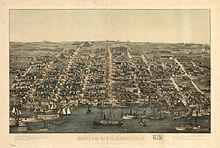
Buildings at Virginia Theological Seminary and at Episcopal High School also served as hospitals for union troops. Bullets, belt clips, and other artifacts from the Civil War have been found in those areas well into the 20th century. Christ Church, because of its association with George Washington, was not closed, but came under the control of army chaplains for the duration of the war.
For African American escaped slaves, the military occupation of Alexandria created opportunity on an unprecedented scale. As Federal troops extended their occupation of the seceded states, escaped slaves flooded into Union-controlled areas. Safely behind Union lines, the cities of Alexandria and Washington offered not only comparative freedom, but employment. Over the course of the war, Alexandria was transformed by the Union occupiers into a major supply depot and transport and hospital center, all under army control.
Because the escaped slaves were still legally property until the abolition of slavery, they were labeled as contrabands to prevent their being returned to their masters. Contrabands took positions with the army as construction workers, nurses and hospital stewards, longshoremen, painters, wood cutters, teamsters, laundresses, cooks, gravediggers, personal servants, and ultimately as soldiers and sailors. According to one statistic, the population of Alexandria had exploded to 18,000 by the fall of 1863 ae an increase of 10,000 people in 16 months.
As of ratification of the Fifteenth Amendment, Alexandria County aos black population was more than 8,700, or about half the total number of residents in the County. This newly enfranchised constituency provided the support necessary to elect the first black Alexandrians to the City Council and the Virginia Legislature.
The population of contrabands flooding into Alexandria during the Union occupation included many who were destitute, malnourished and in poor health. Once in Alexandria, the contrabands were housed in barracks and hastily assembled shantytowns. In the close quarters with poor sanitation, smallpox and typhoid outbreaks were prevalent and death was common. In February 1864, after hundreds of contrabands and freedmen had perished, the commander of the Alexandria military district, General John P. Slough, seized a parcel of undeveloped land at the corner of South Washington and Church Streets from a pro-Confederate owner to be used as a cemetery specifically for burial of contrabands. Burials started in March that year.
The cemetery operated under General Slough's command. Its oversight was supervised by Alexandria aos Superintendent of Contrabands, the Rev. Albert Gladwin, who made arrangements for burials. Each grave was identified with a whitewashed, wooden grave marker. In 1868, after Congress ended most functions of the Freedmen's Bureau, the cemetery was closed; and the property was returned to its original owners. Eventually, after the grave markers had rotted and ownership had transferred several times, the property was redeveloped for commercial use. During its five years of operation, about 1800 contrabands and freedmen were buried in the cemetery.
Beginning in 1987, when memory of the cemetery was revived, the City of Alexandria began the process of saving the cemetery to create a memorial park. During 2008, submissions in a design competition for the memorial were received from 20 countries, and a design for the memorial was selected. As of late 2008, construction of the memorial was underway. As Contrabands and Freedmen Cemetery, the cemetery was listed on the U.S. National Register of Historic Places in August, 2012.
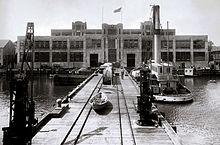
In 1914, Agudas Achim Congregation was founded. In 1930, Alexandria annexed the Town of Potomac. That town, adjacent to Potomac Yard, had been laid out beginning in the late 19th century and incorporated in 1908. In 1969 and 1976 Pope John Paul II visited Alexandria when he was known as Karol Cardinal WojtyÅaa. He was guided by a Polish Catholic priest from St. Mary's Catholic Church in Alexandria.
In 1999 the city celebrated its 250th anniversary.
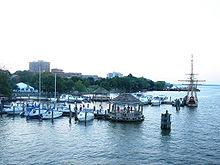
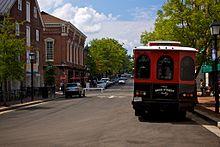
According to the United States Census Bureau, the city has a total area of 15.4 square miles (39.9 km ²), of which 15.2 square miles (39.3 km ²) are land and 0.2 square mile (0.6 km ²) is water. The total area is 1.49% water. Alexandria is bounded on the east by the Potomac River, on the north and northwest by Arlington County, and on the south by Fairfax County. The western portions of the city were annexed from those two entities beginning in the 1930s.
The addressing system in Alexandria is not uniform and reflects the consolidation of several originally separate communities into a single city. In Old Town Alexandria, building numbers are assigned north and south from King Street and west (only) from the Potomac River. In the areas formerly in the Town of Potomac, such as Del Ray and St. Elmo, building numbers are assigned east and west from Commonwealth Avenue and north (only) from King Street. In the western parts of the city, building numbers are assigned north and south from Duke Street.
The ZIP code prefix 223 uniquely identifies the Alexandria postal area. However, the Alexandria postal area extends into Fairfax County and includes addresses outside of the city. Delivery areas have ZIP codes 22301, 22302, 22304, 22305, 22311, 22312, and 22314, with other ZIP codes in use for post office boxes and large mailers.
Alexandria lies within the Humid subtropical climate zone, experiencing hot, humid summers, mild to chilly winters, and generous precipitation year-round. July is the warmest month of the year, with an average temperature of 80 °F (26.7 °C). Summer is a season of high humidity in the region, with frequent afternoon thunderstorms. January is the coldest month of the year with an average temperature of 36 °F (2.2 °C). Winter often brings lighter rain showers of longer duration, and occasional brief snowfall. Average annual precipitation is 38.93 inches (98.9 cm). Alexandria's relative inland location to the Chesapeake Bay give the area a climate that is a few degrees cooler than areas to the east such as Annapolis or Baltimore.
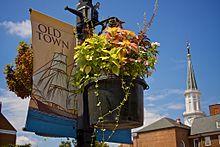
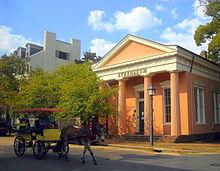
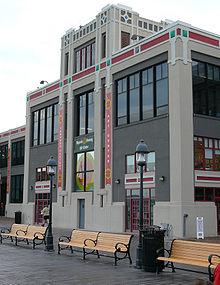
Old Town, in the eastern and southeastern areas of Alexandria and on the Potomac River, is the oldest section of the city, originally laid out in 1749, and is a historic district. Old Town is chiefly known for its historic town houses, art galleries, antique shops, and restaurants. Some of the historic landmarks in Old Town include General Robert E. Lee's boyhood home, the Lee-Fendall House, a replica of George Washington's townhouse, Gadsby's Tavern, the Stabler-Leadbeater Apothecary Shop, and the Torpedo Factory art studio complex (see the "Recreation" paragraph below). River cruise boats and street entertainers frequent the large plaza at the foot of King Street; the Mount Vernon Trail also passes through. Old Town is laid out on a grid plan of substantially square blocks. The opening of the Washington Metro King Street station in 1983 led to a spurt of new hotel and office building development in western Old Town, and gentrification of townhouse areas west of Washington Street which were previously an African-American community.
Market Square in Old Town is believed to be one of the oldest continuously operating marketplaces in the United States, (from 1753 until present day), and was once the site of the second-largest slave market in the U.S. Today it contains a large fountain and extensive landscaping, as well as a farmers' market each Saturday morning.
In the center of the intersection of Washington and Prince streets stands a statue of a lone Confederate soldier which marks the spot where CSA units from Alexandria left to join the Confederate Army at the beginning of the American Civil War. The piece is entitled Appomattox and was cast by M. Casper Buberl in 1889.
Just to the west of Old Town is the city's oldest planned residential expansion. Called by its creators Rosemont in honor of a Philadelphia, Pennsylvania neighborhood of the same name, Rosemont was developed between 1900 and 1920. Rosemont extends from the foot of Shuter's Hill, crowned by the George Washington National Masonic Memorial away to the north for a dozen blocks to the edge of Del Ray. Originally intended as a "streetcar suburb" connected to Washington, D.C. and George Washington's home at Mount Vernon by electric railroad, Rosemont, instead, became closely integrated into the life of the core of Alexandria. Much of Rosemont is included in a historic district listed on the National Register of Historic Places that was intended to focus attention on the neighborhood's role as a showcase of early 20th Century home building styles. Television weatherman Willard Scott grew up here.
At the northern limits of Old Town are the remnants of a historic, predominantly African American community known by its inhabitants as "The Berg." The area was settled in 1861 by refugees fleeing from enslavement in the Petersburg, VA area and was originally known as Petersburg or Grantsville. In 1915 the neighborhood encompassed several blocks from 1st St. to Bashford Lane and Royal St. to the waterfront railroad line.
Built in 1945, a 260-unit public housing complex covers several blocks in what is now Old Town Alexandria. Today the Berg aos most prominent landmarks are the James Bland Homes (built in 1954) named after an African American musician and songwriter, and the Samuel Madden Homes, named after the second African-American pastor of the Alfred Street Baptist Church,.
Over the years the historic roots of the Berg aos name were lost, and many assumed it referred to the monolithic, iceberg-like buildings of this apartment complex. It was mentioned in the movie Remember the Titans, which dramatizes the integration of city public schools in the 1970s
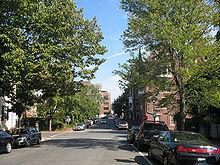
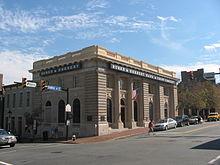
Arlandria is a neighborhood located in the north-eastern portion of Alexandria. Its name is a portmanteau of the words "Arlington" and "Alexandria," reflecting its location on the border of Arlington County and Alexandria. The neighborhood's borders form a rough triangle bounded by Four Mile Run in the north, West Glebe Road to the south and south-west, and Route 1 to the east. Centered around Mount Vernon Avenue between Four Mile Run and West Glebe Road, it is home to many Hispanic, Thai, and Vietnamese-owned bakeries, restaurants, salons, and bookstores. An influx of Salvadorean immigrants into the neighborhood in the 1980s has earned it the nickname "Chirilagua," after the city on the Pacific coast of El Salvador. Arlandria is also home to the Birchmere concert hall, the Alexandria Aces of the Cal Ripken, Sr. Collegiate Baseball League, and St. Rita Roman Catholic Church, dedicated in 1949 and constructed in Gothic style from Virginia fieldstone and Indiana limestone. Alternative rock band the Foo Fighters has a track titled "Arlandria" on their 2011 release Wasting Light. Front-man (and ex-Nirvana drummer) Dave Grohl lived in Alexandria during his childhood. The area is also referenced in the song "Headwires" from the band's 1999 release, There Is Nothing Left to Lose.
The area to the northwest of Old Town, formerly in the separate town of Potomac, is popularly known as Del Ray, although that name properly belongs to one of many communities (including Hume, Mount Ida, and Saint Elmo's) in that area. The communities of Del Ray and St. Elmo's originated in early 1894, when developer Charles Wood organized them on a grid pattern of streets running north-south and east-west. Del Ray originally contained six east-west streets and five north-south. All were identical in width, except Mt. Vernon Avenue, which was approximately twenty feet wider. St. Elmo's, a smaller tract, was laid out in a similar pattern, but with only four east-west streets and one running north-south.
By 1900, Del Ray contained approximately 130 persons, and St. Elmo 55. In 1908, the tracts of Del Ray, St. Elmo's, Mt. Ida, and Hume were incorporated into the town of Potomac, which by 1910 had a population of 599; by 1920 it contained 1,000; by 1928 it had 2,355 residents; now more than 20,000 people live in Del Ray.
The 254 acres (1 km ²) comprising Del Ray were sold to Charles Wood in 1894 for the sum of $38,900, while St. Elmo, made up of 39 acres (160,000 m2), was purchased for $15,314.
The community, while still diverse, has experienced substantial gentrification since the development of the Potomac Yard Shopping Center in the mid-1990s. It draws tens of thousands of people from around the Washington, D.C. region during its annual Art on the Avenue main street festival the first Saturday in October. New development under way in formerly unused land near Potomac Yard, across US Route 1 from Del Ray, will include condominiums, offices, parks, and a fire station with affordable housing on upper floors.
Alexandria's West End includes areas annexed from Fairfax County in the 1950s. It is the most typically suburban part of Alexandria, with a street hierarchy of winding roads and cul-de-sacs. The section of Duke Street in the West End is known for a high-density residential area known to locals as "Landmark" due to its close proximity to nearby Landmark Mall, and for its concentration of strip and enclosed shopping malls. In more recent years, parts of Alexandria's West End have seen an influx of immigrants from Ethiopia, Eritrea, Afghanistan and Pakistan, who have settled in the areas surrounding Seminary Road west of I-395.
The West End is composed of four main areas. All are west of Quaker Lane, the main north-south artery through Alexandria:
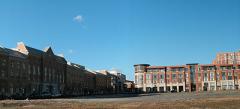
North Ridge, in northern Alexandria city, includes the busy east-west Braddock Road/King Street corridors and north-south arteries Russell Rd (to the East) and Cameron Mill Rd. North Ridge takes its name from the high ground west of Russell Road and south of West Glebe Road. Within the area that comprises North Ridge are the neighborhoods of Beverly Hills, Jefferson Park, Braddock Heights, Timber Branch, Parkfairfax, Monticello Park, Beverly Estates, and Oak Crest. It is a residential area with homes of numerous styles with mostly single family two-story & basement houses that were largely developed in the period of the 1930s through the early 1960s. The Lower School of private St. Stephen's & St. Agnes School is located in the Jefferson Park neighborhood of North Ridge. This neighborhood includes many houses of worship as well as one of Virginia's eight Scottish Rite temples, a Masonic order. Alexandria City Fire Station #203 is located at Cameron Mills Rd & Monticello Blvd and an Alexandria Police Satellite Facility borders North Ridge located at King St & W. Braddock Rd. On the edge of the community is a small shopping center called Fairlington anchored by a national-chain drug store and a Cadillac car dealership. North Ridge students attend George Mason and Charles Barrett Elementary Schools and feed into George Washington Middle School and T. C. Williams High School. Parks include Monticello Park, Beverly Park and Robert Leider Park. The North Ridge community lies within the original 10-mile (16 km) square of the District of Columbia, ceded back to Virginia in 1846.
Many neighborhoods outside of the city limits, including Hollin Hills, Franconia, Groveton, Hybla Valley, Huntington, Belle Haven, Mount Vernon, Fort Hunt, Engleside, Burgundy Village, Waynewood, Wilton Woods, Rose Hill, Virginia Hills, Hayfield, and Kingstowne use an Alexandria address. Despite the Alexandria address, these areas are actually part of Fairfax County, not the City of Alexandria. To maintain the political/geographical division here, many locals refer to the non-Alexandria City area that has an Alexandria zip code as "Alexandria South."
As of the census of 2010, there were 139,966 people, 68,082 households, and 30,978 families residing in the city. The population density was 8,452.0 people per square mile (3,262.9/km ²). There were 68,082 housing units at an average density of 4,233.2 per square mile (1,634.2/km ²). The racial makeup of the city was:
In 2000 there were 61,889 households out of which 18.6% had children under the age of 18 living with them, 32.2% were married couples living together, 9.2% had a female householder with no husband present, and 55.2% were non-families. 43.4% of all households were made up of individuals and 6.8% had someone living alone who was 65 years of age or older. The average household size was 2.04 and the average family size was 2.87.
The age distribution was 16.8% under the age of 18, 9.2% from 18 to 24, 43.5% from 25 to 44, 21.5% from 45 to 64, and 9.0% who were 65 years of age or older. The median age was 34 years. For every 100 females there were 93.5 males. For every 100 females age 18 and over, there were 91.7 males.
According to a 2007 estimate, the median income for a household in the city was $80,806, and the median income for a family was $102,435. Males had a median income of $47,514 versus $41,254 for females. The per capita income for the city was $37,645. 8.9% of the population and 6.8% of families were below the poverty line. 13.9% of those under the age of 18 and 9.0% of those 65 and older were living below the poverty line.
Like many American cities, Alexandria has experienced a substantial decline in overall crime since 1970, hitting a 45 year low in 2010. The city's Alexandria Police Department is responsible for police services in the city. There are 320 officers and 138 administrative workers. Since 2002, the police department has put crime information online.
The total number of violent crimes have been declining on average since 1997 for Alexandria. There were 288 cases of aggravated assault for 1997. The average since then has been 204 per year. The high point for burglary was reached in 1997 with 819 break-ins, as well as 813 reports of auto theft, the highest recorded total for the city. The average number of stolen autos for every year since then has been 672. The number of crimes per 1,000 people has also been declining, from 56 in 1997 to 27 in 2006. According to the Police Executive Research Forum, in Alexandria, "street violence is overrepresented in the Hispanic community."
According to the City's 2011 Comprehensive Annual Financial Report, the top public employers in the city are:
The top private employers in the city are:
Other companies headquartered in Alexandrian include VSE and the Pentagon Federal Credit Union.
Alexandria is home to numerous trade associations, charities, and non-profit organizations including the national headquarters of groups such as the American Diabetes Association, BoatUS, Catholic Charities, Gifts In Kind International, Global Impact, Islamic Relief USA, United Way, Volunteers of America and the Salvation Army. Other organizations located in Alexandria include American Coalition for Clean Coal Electricity, the Society for Human Resource Management and the National Beer Wholesalers Association.
The city is served by the Alexandria City Public Schools system and by the Alexandria campus of Northern Virginia Community College. The largest seminary in the Episcopal Church, Virginia Theological Seminary, is located on Seminary Road. Virginia Tech's Washington-Alexandria Architecture Center, also known as WAAC, is located on Prince Street in Old Town, offering graduate programs in Urban Affairs and Planning, Public and International Affairs, Architecture, and Landscape Architecture. Virginia Commonwealth University operates a Northern Virginia branch of its School of Social Work and The George Washington University (Washington DC) also has a campus near the King Street metro. This campus mainly offers professional and vocational programs, such as an executive MBA program, urban planning and security studies.
Alexandria is home to several of the Washington D.C. area's top private schools, such as Burgundy Farm Country Day, St. Stephen's and St. Agnes School, Bishop Ireton High School, and Episcopal High School. Also in the city are Alexandria Country Day School, Commonwealth Academy, St. Mary's Catholic School, St. Rita's Catholic School, Blessed Sacrament Learning Center and Global Health College.
Alexandria's public school system consists of thirteen elementary schools for grades 5-year-old Kindergarten through Grade 5. Middle Schools, George Washington and Francis C. Hammond, serve 6th through 8th graders. Minnie Howard Ninth Grade Center and T.C. Williams High School serve grades 9th and 10 through 12, respectively, for the entire city.
The demographics of Alexandria City Public Schools contrast with those of the city. As of 2008, only 14% of the students at Francis C. Hammond Middle School were non-Hispanic whites, compared to about 60% when looking at the city as a whole. 27% were of Hispanic descent, and 48% were black. About 9% of the school was of Asian descent. As of 2004, 62% of the school received free lunches. As of 2008, that number had decreased to 56%. At George Washington Middle School, 30% of students are non-Hispanic whites, 24% were Hispanic, and 41% was black. 3% of the students were Asian, and 52% of students received free lunch. T.C. Williams High School follows this trend as well; 23% of the students were classified as non-Hispanic whites, 25% as Hispanic, and 44% as black. 7% of the school was Asian, and 47% of all students received free lunch.
Alexandria has a distributed park system with approximately 950 acres (3.8 km ²) spread across 70 major parks and 30 recreation centers, of which Chinquapin is one of the largest. Chinquapin offers facilities for swimming, tennis, racquetball, and other sports. The city also organizes several sports leagues throughout the year including volleyball, softball and basketball.
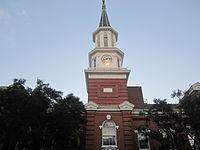
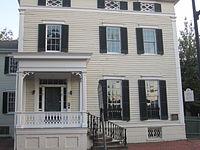
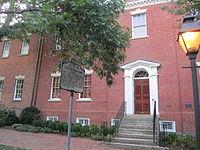
The city is unusual in that Cameron Run Regional Park includes a water park with a wave pool and water slides, as well as a miniature golf course and batting cages aefacilities usually operated by private companies. A portion of the Mount Vernon Trail, a popular bike and jogging path, runs through Old Town near the Potomac River on its way from the Mount Vernon Estate to Roosevelt Island in Washington, DC. There is also a largely unbroken line of parks stretching along the Alexandria waterfront from end to end.
Landmarks within the city include the George Washington Masonic National Memorial (also known as the Masonic Temple) and Observation Deck, Christ Church, Gadsby's Tavern, John Carlyle House, Little Theatre of Alexandria, Lee-Fendall House, Alexandria City Hall, Market Square, the Jones Point Light, the south cornerstone of the original District of Columbia, Robert E. Lee's boyhood home, the Torpedo Factory Art Center, and the Virginia Theological Seminary. Other sites of historical interest in the city include Alexandria Black History Resource Center, Fort Ward Park and Museum, and the Alexandria Canal lock re-creation at Canal Office Center. Interesting sites with Alexandria addresses but outside of the city limits include River Farm, Collingwood Library & Museum, Green Spring Gardens Park, Huntley Meadows Park, Pope-Leighey House (designed by Frank Lloyd Wright), Woodlawn Plantation, Washington's Grist Mill and Mount Vernon Estate.
In 1830, John Hollensbury's home in Alexandria was one of two homes directly boarding an alleyway that received a large amount of horse-drawn wagon traffic and loiterers. In order to prevent people from using the alleyway, Hollensbury constructed a 7 feet (2.1 m) wide, 25 feet (7.6 m) deep, 325-square-foot (30.2 m2), two story home using the existing brick walls of the adjacent homes for the sides of the new home. The brick walls of the Hollensbury Spite House living room have gouges from wagon-wheel hubs and the house still is standing and occupied.
Due to its proximity to Washington, Alexandria has only been the home of one professional sports team, the Alexandria Dukes, a minor league baseball team which has moved to Woodbridge and is currently named the Potomac Nationals. However, the Cal Ripken, Sr. Collegiate Baseball League brought baseball back to Alexandria in 2008 in the form of the Alexandria Aces. In addition, TC Williams, Bishop Ireton, St. Stephen's and Episcopal have storied histories in athletics, such as football, basketball, baseball and lacrosse. The largest youth sport in Alexandria is soccer with almost 2,500 players ages 2 ae18 who participate in Alexandria Soccer Association.
Alexandria is bisected north and south by State Route 7, known in most of the city as the major thoroughfare of King Street. Interstate 95/495 (the Capital Beltway), including the Woodrow Wilson Bridge over the Potomac River, approximately parallels the city's southern boundary with Fairfax County. Interstate 395 crosses through the western part of the city. Other major routes include U.S. 1 (named Jefferson Davis Highway, and Patrick and Henry Streets after Patrick Henry, and Richmond Highway), the George Washington Memorial Parkway, and Duke Street (State Route 236).
Alexandria is located just south of Ronald Reagan Washington National Airport in Arlington County. As with other Washington suburbs, Alexandria is also served by Washington Dulles International Airport in Sterling, Virginia and by Baltimore-Washington International Thurgood Marshall Airport near Baltimore, Maryland.
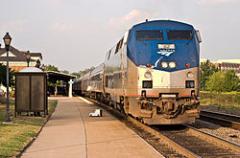
Alexandria Union Station, the city's historic train station, is served by both Amtrak intercity and Virginia Railway Express regional rail service. The station is directly adjacent to the King Street ae Old Town Washington Metro station, at the convergence of the Blue and Yellow Lines. Three other Metro stations that lie within the city limits are Braddock Road, Van Dorn Street, and Eisenhower Avenue.
The traditional boundary between Old Town and the latterly annexed sections of the city followed the railway now owned by CSX Transportation.
The city government operates its own mass transit system, the DASH bus, connecting points of interest with local transit hubs. Metrobus, Washington Metro, and the Virginia Railway Express better known as the VRE also serves Alexandria. The city also offers a free trolley service on King Street from the King Street Metro Station to the Waterfront and a water taxi to and from the National Harbor development in Prince George's County, Maryland.
As an independent city of Virginia (as opposed to an incorporated town within a county), Alexandria derives its governing authority from the Virginia General Assembly. In order to revise the power and structure of the city government, the city must request the General Assembly to amend the charter. The present charter was granted in 1950 and it has been amended in 1968, 1971, 1976, and 1982.
Alexandria adopted a council-manager form of government by way of referendum in 1921. This type of government empowers the elected City Council to pass legislation and appoint the City Manager. The City Manager is responsible for overseeing the city's administration.
As of 2008, the City of Alexandria had 78 standing local boards, commissions, and committees to advise the City Council on major issues affecting the community. All members are appointed by the City Council.
Alexandria is part of Virginia's 8th congressional district, represented by Democrat Jim Moran, elected in 1990.
The state's senior member of the United States Senate is Democrat Jim Webb, elected in 2006. The state's junior member of the United States Senate is Democrat Mark Warner, elected in 2008. The Governor of Virginia is Republican Bob McDonnell, elected in 2009 along with Lt. Governor Bill Bolling and Attorney General Ken Cuccinelli
In 2008, the Alexandria City Council approved an "Eco-City" charter with the goal of guiding the city and its residents toward "sustainability." The term "Eco-City" was first coined by Richard Register in his 1987 book "Ecocity Berkeley: building cities for a healthy future." An "Eco-City" is typically defined as one in which inhabitants are dedicated to the minimal consumption of energy, water and food as well as minimal production of air and water pollution. Alexandria, however, defined sustainability instead as meeting the city's present needs while preserving its historic character and ensuring the ability of future generations to meet their own needs.
Alexandria has four sister cities, as designated by Sister Cities International:
Alexandria was twinned with Gyumri as a means of showing goodwill in the wake of the 1988 earthquake. Some Armenian architects were invited to study in Virginia and an Alexandria-Gyumri Armenian festival is held around City Hall every year in June, the date of which is declared Armenia Day in Alexandria by the mayor.
Alexandria has been twinned with Caen, France since 1991. The sister city relationship sees delegations visiting between the two cities on a regular basis. Exchanges of students have been common. Musicians and choirs from the two cities have also made very successful visits. In most years, members of the Alexandria-Caen Sister City Committee travel to Caen for the foire de Caen, a large international trade fair held in mid-September. Along with Caen's other sister cities, the Alexandria delegation has the chance to introduce its city to the people of Normandy, while getting the chance to learn more about this historic region of France. An office in the Alexandria City Hall is there for the projects with Sister Cities.
Word Count: 7434






